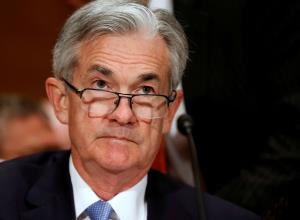3 Key Takeaways From The Fed Minutes

Fed Chairman Jerome Powell
The Federal Reserve released the minutes from its January 30-31 Federal Open Market Committee meeting. The minutes were much-watched by financial markets, particularly on the Fed's path to future rate hikes. Below are four key takeaways from the minutes.
The Fed Affirmed Gradual Approach To Rate Hikes
Federal Reserve Comments
They judged that a gradual approach to raising the target range would sustain the economic expansion and balance the risks to the outlook for inflation and unemployment. Members agreed that the strengthening in the near-term economic outlook increased the likelihood that a gradual upward trajectory of the federal funds rate would be appropriate. They, therefore, agreed to update the characterization of their expectation for the evolution of the federal funds rate in the post-meeting statement to point to “further gradual increases” while maintaining the target range at the current meeting.
My Interpretation
Even after a few rate hikes by former Fed Chairwoman Janet Yellen the fed funds rate stands at 1.5%. If 2.0% is considered a "normalized" level then Fed policy could still be considered accommodative for the economy and financial markets. I assumed new Fed Chairman Jerome Powell would look to normalize the fed funds rate as quickly as possible. After all, if the Fed policy remains accommodative for more than a decade then how do we know if its actions to spur the economy are actually working?
The Fed's reference to a "gradual approach" to raising the target range for the fed funds rate could be interpreted that it will look to hike rates once or twice this year. The Fed might not take a knee-jerk reaction to the 2.9% wage growth reported in the January jobs report. This could have a calming effect on financial markets. Ultimately, the Fed will remain data depending before hiking rates. Other than January wage growth I have not seen economic data that would imply inflation fears are warranted.
A Sustained Return To 2 Percent Inflation
Fed Comments
After assessing current conditions and the outlook for economic activity, the labor market, and inflation, members voted to maintain the target range for the federal funds rate at 1¼ to 1½ percent. They indicated that the stance of monetary policy remained accommodative, thereby supporting strong labor market conditions and a sustained return to 2 percent inflation. Members agreed that the timing and size of future adjustments to the target range for the federal funds rate would depend on their assessments of realized and expected economic conditions relative to the Committee’s objectives of maximum employment and 2 percent inflation.
My Interpretation
In the past, the Fed has used personal consumption expenditures ("PCE") as the metric to measure inflation. The index grew 1.5% in 2014 - the year Janet Yellen took over as Fed Chairwoman. It fell to as low as 0.3% in 2015 and ended at 1.7% in 2017. As of now, there is no evidence PCE will reach 2% anytime soon. It could portend that the Fed's stimulus efforts have been good at raising asset prices (stocks and real estate), yet the stimulus has not trickled down to the rest of the economy.
If the Fed remains data dependent and continues to use PCE as its barometer for inflation it could be difficult to make a case for multiple rate hikes this year. Of note, as that the Fed is expected to gradually unwind its $4 trillion bond portfolio, selling pressure could drive down prices of the long bond and drive up yields over the next few years.
No Clear Signs Of A Pickup In Wage Growth
Fed Comments
The unemployment rate, at 4.1 percent, had remained near the lowest level seen in the past 20 years. It was noted that other labor market indicators — such as the U-6 measure of unemployment or the share of involuntary part-time employment — had returned to their pre-recession levels. A few participants judged that while the labor market was close to full employment, some margins of slack remained; these participants pointed to the employment-to-population ratio or the labor force participation rate for prime-age workers, which remained below pre-recession levels, as well as the absence to date of clear signs of a pickup in aggregate wage growth.
My Interpretation
I agree with the Fed on this issue. Financial markets experienced volatility after the January Jobs Report showed 2.9% wage growth - the fastest rate of growth since 2009. Investors interpreted this as a sign of inflation and financial markets sold off briefly. January's wage growth was much higher than the 0.3% reported in December 2017. The question remains, "Is wage growth sustainable?" In my opinion, wages would give to grow at 2.9% or higher for a few more months before it could prompt the Fed change course on rate hikes.
Secondly, despite a 4.1% unemployment rate signaling full-employment, there are still signs that suggest labor is weak. The civil labor participation rate - the section of the working population still employed or seeking employment - was 62.7% in January 2018. The figure touched 62.3% in September 2015; prior to that, the labor participation rate had not been this low since the late 1970s when the country endured an economic malaise under President Jimmy Carter. Taken in totality hourly wage growth, the unemployment rate and the labor participation rate does not suggest clear signs of wage growth.



